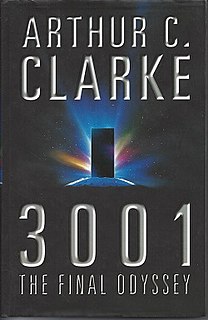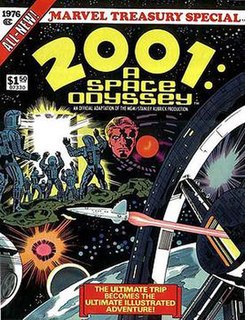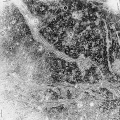HAL 9000 is a fictional artificial intelligence character and the main antagonist in Arthur C. Clarke's Space Odyssey series. First appearing in the 1968 film 2001: A Space Odyssey, HAL is a sentient artificial general intelligence computer that controls the systems of the Discovery One spacecraft and interacts with the ship's astronaut crew. While part of HAL's hardware is shown toward the end of the film, he is mostly depicted as a camera lens containing a red or yellow dot, instances of which are located throughout the ship. HAL 9000 is voiced by Douglas Rain in the two feature film adaptations of the Space Odyssey series. HAL speaks in a soft, calm voice and a conversational manner, in contrast to the crewmen, David Bowman and Frank Poole.

2010: Odyssey Two is a 1982 science fiction novel by British writer Arthur C. Clarke. It is the sequel to the 1968 novel 2001: A Space Odyssey.
The Space Odyssey series is a series of science fiction novels by the writer Arthur C. Clarke. Two of the novels have been made into feature films, released in 1968 and 1984 respectively. Two of Clarke's early short stories may also be considered part of the series.

2061: Odyssey Three is a science-fiction novel by the British writer Arthur C. Clarke, published in 1987. It is the third book in Clarke's Space Odyssey series series. It returns to one of the lead characters of the previous novels, Heywood Floyd, and his adventures from the 2061 return of Halley's Comet to Jupiter's moon Europa.

3001: The Final Odyssey is a 1997 science fiction novel by British writer Arthur C. Clarke. It is the fourth and final book in Clarke's Space Odyssey series.

James "Blood" Ulmer is an American jazz, free funk and blues guitarist and singer. Ulmer plays a Gibson Byrdland guitar. His guitar sound has been described as "jagged" and "stinging". His singing has been called "raggedly soulful".

In Arthur C. Clarke's Space Odyssey, Monoliths are machines built by an unseen extraterrestrial species. In the series of novels, three Monoliths are discovered in the Solar System by hominids and humans. The response of the characters to their discovery drives the plot of the series. It also influences the fictional history of the series, particularly by encouraging humankind to progress with technological development and space travel.

2001: A Space Odyssey is an oversized American comic book adaptation of the 1968 film of the same name as well as a ten-issue monthly series which expanded upon the concepts presented in the Stanley Kubrick film and the novel by Arthur C. Clarke. Jack Kirby wrote and pencilled both the adaptation and the series, which were published by Marvel Comics beginning in 1976. The adaptation was part of the agreement of Kirby's return to Marvel.

The planet Jupiter, the largest planet in the solar system, is a popular backdrop for science fiction stories and films. Early works of science fiction used Jupiter itself as a location for stories, but modern science has shown that the planet has no solid surface one could land on and that its atmosphere, temperature, high gravity and intense radiation is hostile to human life. As a result, the Jovian system as a whole, including both the space around Jupiter and its very extensive system of moons, is a more common setting for science fiction.

Jupiter's extensive system of natural satellites – in particular the four large Galilean moons – has been a common science fiction setting.
7794 Sanvito, provisional designation 1996 AD4, is a bright Vestian asteroid from the inner regions of the asteroid belt, approximately 4.6 kilometers (2.9 miles) in diameter. It was discovered on 15 January 1996, by Italian astronomers Ulisse Munari and Maura Tombelli at the Cima Ekar Observing Station in Tuscany, Italy. The likely V-type asteroid was named after Italian amateur astronomer Roberto di San Vito.

Sir Arthur Charles Clarke was an English science-fiction writer, science writer, futurist, inventor, undersea explorer, and television series host.
Ganymede most commonly refers to:
The following is a list of works by Arthur C. Clarke.
On July 15th, 1996, President Bill Clinton issued Executive Order 13010. This executive order addressed the concerns regarding infrastructure by listing critical infrastructures, identifying threats to critical infrastructures, and establishing the President's Commission on Critical Infrastructure Protection.
The region of the Solar System beyond Neptune contains sparse populations of relatively small rocky and icy objects. These include the Kuiper belt, a group which includes the dwarf planet Pluto and other large planetoids such as Haumea and Makemake. Further out is the scattered disk, a group which includes Eris, a dwarf planet slightly smaller than Pluto, and even more distant detached objects such as Sedna.

2001: A Space Odyssey is a 1968 epic science fiction film produced and directed by Stanley Kubrick. The screenplay was written by Kubrick and Arthur C. Clarke, and was inspired by Clarke's 1951 short story "The Sentinel" and other short stories by Clarke. A novel released after the film's premiere was in part written concurrently with the screenplay. The film, which follows a voyage to Jupiter with the sentient computer HAL after the discovery of an alien monolith affecting human evolution, deals with themes of existentialism, human evolution, technology, artificial intelligence, and the possibility of extraterrestrial life.
In his lifetime Arthur C. Clarke participated in film, television, radio and other media in a number of different ways.

Emmi Elina Itäranta is a Finnish novelist. Her debut novel Memory of Water was published by HarperCollins in 2014.












